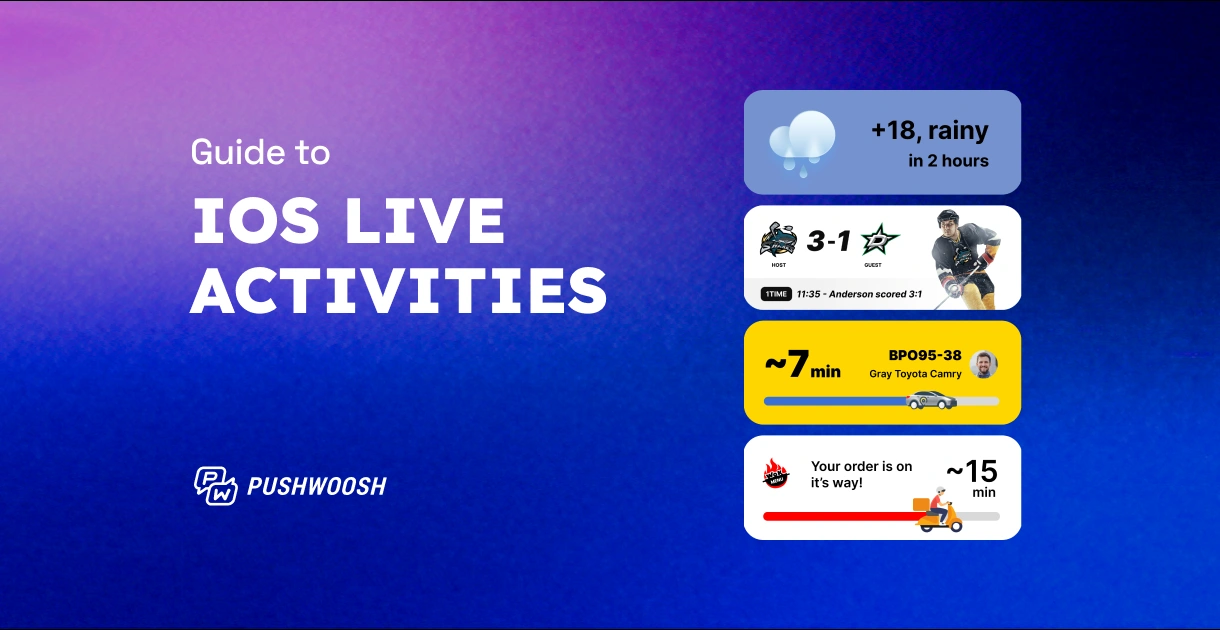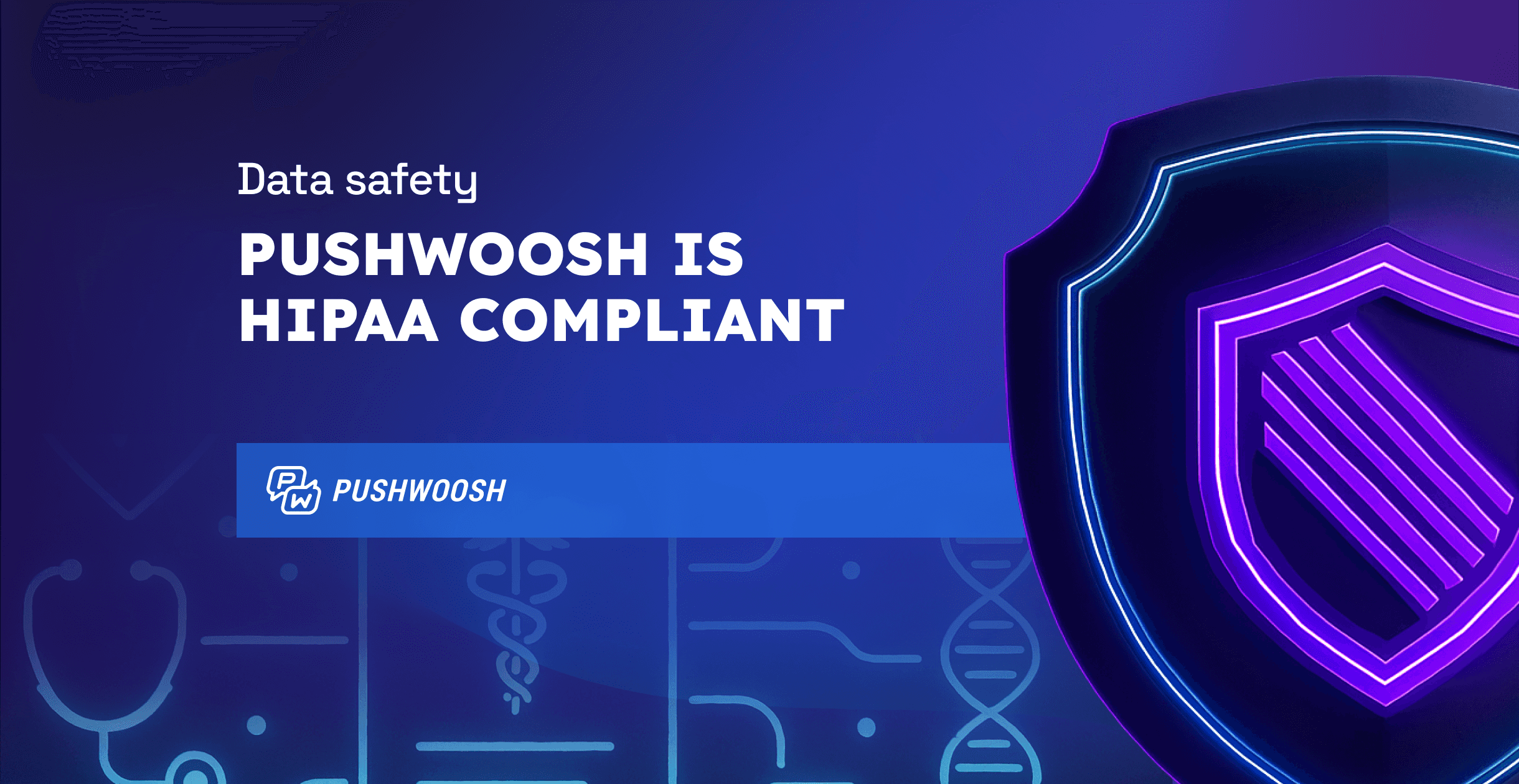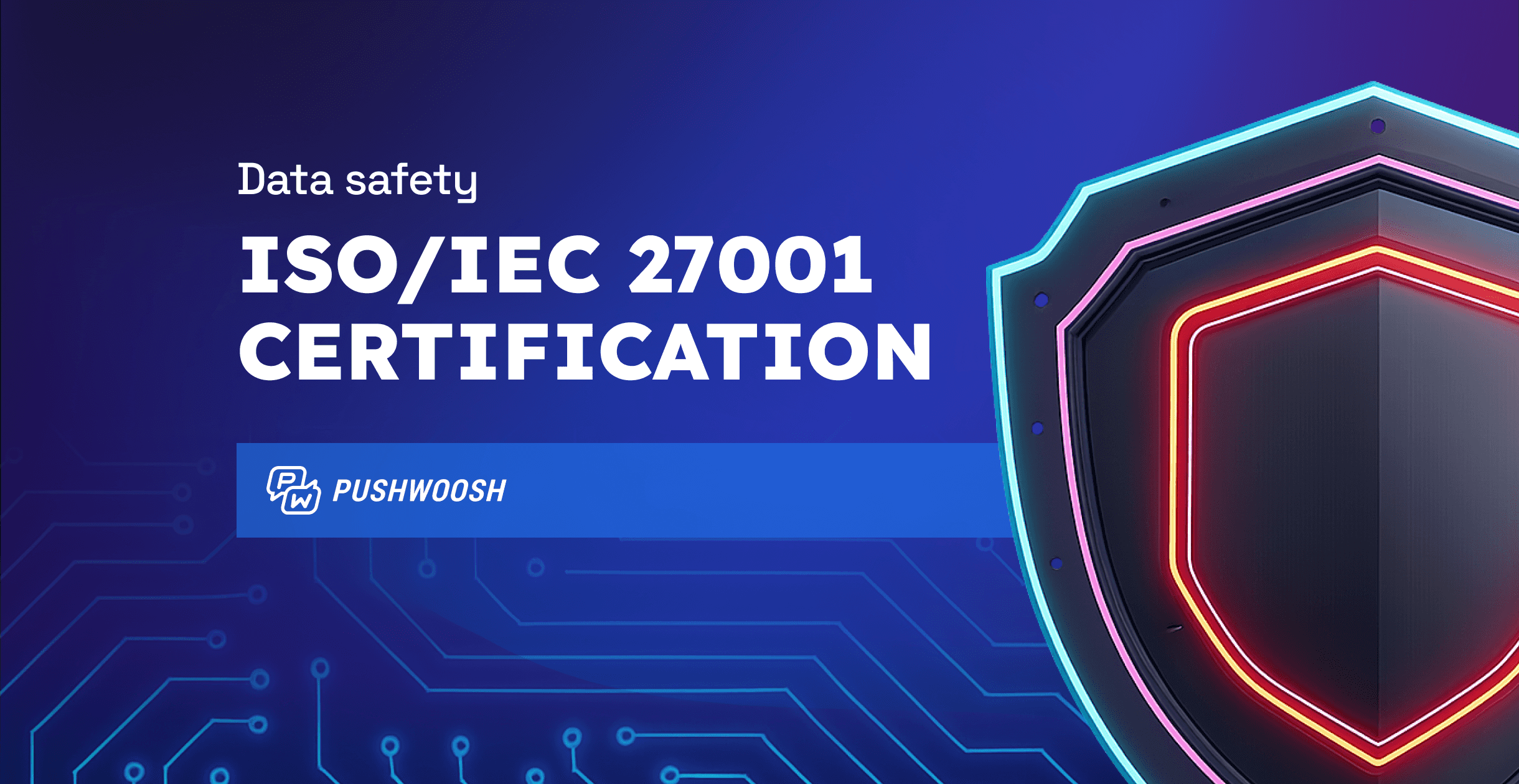iOS Live Activities: How they work, examples & best practices
Your users want real-time updates, but not a flood of notifications. iOS Live Activities bridge that gap, giving apps a new surface to deliver high-value, dynamic updates without interrupting the user experience.
This guide explains what Live Activities are, how they work, the latest iOS 18 changes, best examples, and how to use them to increase retention and engagement. And along the way, you’ll see how Pushwoosh helps apps manage Live Activities effortlessly.
What are iOS Live Activities?
iOS Live Activities are real-time, glanceable widgets that appear on the iPhone Lock Screen and Dynamic Island. Instead of sending multiple push notifications to keep users updated, Live Activities present continuously refreshed information in a single, persistent surface, visible even when the device is locked.
They’re designed for moments where users want to track something unfolding right now: an arriving courier, an upcoming flight, a live score, a workout, a timer, or a delivery in progress. Live Activities update automatically as the status changes, giving users instant clarity without unlocking their phone or opening the app.
Apple first introduced them in iOS 16 and has expanded their functionality across iOS 17 and iOS 18, making them more interactive, more adaptive, and more central to the iPhone’s real-time experience.
Why Live Activities matter for mobile apps in 2026
In 2026, winning user attention is harder than ever. Users expect real-time clarity without noise, and iOS Live Activities deliver exactly that.
Here’s why top apps rely on them:
Reduced push fatigue: The average US smartphone user receives 46 app push notifications per day, which contributes to notification fatigue and lower engagement. Live Activities solve this by consolidating multiple updates into a single, persistent surface, maintaining visibility without overwhelming the user.
Stronger habit formation: Predictable, timely updates reinforce routine behaviors. Apps that deliver consistent contextual updates see significantly higher retention over the first 7 days. Live Activities support this pattern by giving users a reliable, “at-a-glance” touchpoint that builds trust and repeat usage.
In a world where retention is the new growth, iOS Live Activities are no longer optional; they’re becoming a new, high-intent engagement surface — one that stays visible longer and drives repeat interaction.
iOS Live Activities vs push notifications
Live Activities and push notifications both help you communicate with users, but they serve very different purposes. Live Activities support continuous, passive tracking; push notifications (including rich push notifications) drive action.
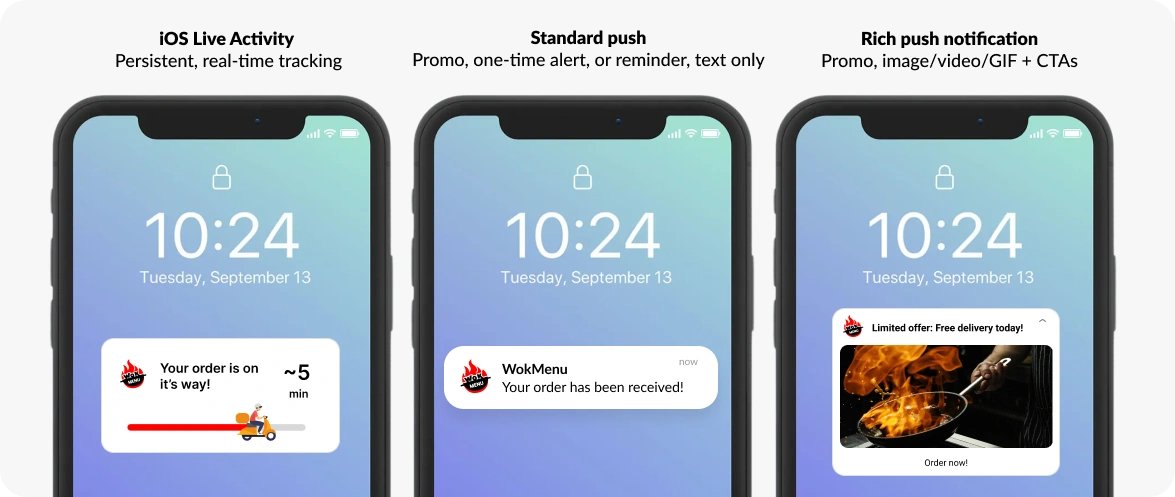
Together, they create a powerful engagement duo. Here’s how they compare:
| Feature/criteria | iOS Live Activities | Standard push notifications | Rich push notifications |
|---|---|---|---|
| Purpose | Continuous, real-time updates for an ongoing event | One-time alerts, reminders, announcements | Same as standard push, but visually enhanced |
| Where they appear & duration | Persistent on the Lock Screen and Dynamic Island, up to 8 hours | Briefly on the Lock Screen, then in Notification Center | Same as standard push |
| Update behavior | Auto-updated via app or server | Static — requires sending another push | Static — requires sending another push |
| User experience | Calm, high clarity; zero-noise tracking | Can feel noisy during time-sensitive events | More engaging but still interruptive |
| Visual content | Compact UI, progress bars, timers, minimal imagery (no rich media) | Text only | Images, GIFs, videos |
| Interactivity | Tap to open app (no buttons) | Basic actions (Open) | Action buttons (e.g., “Buy,” “Track,” “Save”), up to 4 on iOS |
| Best for | Deliveries, rides, ETAs, sports scores, flights, workouts, countdowns | Reminders, urgent alerts, promotions, transactional events | Campaigns, product launches, personalized recommendations |
| User attention | High — persistent, glanceable | Medium — can be ignored or swiped away | Higher — visuals catch attention |
How iOS Live Activities work
iOS Live Activities give users real-time updates without requiring them to open the app. Here’s the simplest way to understand how they function in practice.
When Live Activities appear & what triggers them
A Live Activity shows up on the Lock Screen and, on supported devices, in the Dynamic Island the moment an app starts an eligible real-time event, such as delivery, ride, workout, timer, or live score.
A Live Activity can only begin after a user performs an intentional action inside the app (placing an order, starting a workout, beginning a ride, following a game, etc.). It cannot be started remotely or triggered by a background task.
Once the event occurs, users see a corresponding real-time card on their device, ensuring Live Activities always reflect something the user is actively engaged in.
If you want to start using Live Activities, jump right to the section that explains how to create them with minimal effort.
User permissions
Starting with iOS 17, when a user opts in to push notifications, they automatically opt in to Live Activities by default. Users can manually toggle Live Activities off in Settings, but most don’t, which results in much higher reach compared to earlier versions.
iOS Live Activities limitations
While Live Activities offer one of the most engaging surfaces on iOS, they come with important constraints marketers and product teams should be aware of:
- Limited duration: Live Activities are short-lived by design. Apple limits them to up to 8 hours of active visibility, plus up to 4 additional hours if the user doesn’t dismiss them. They’re not meant for all-day or long-term tracking.
- Not suitable for promotions or ads: Apple prohibits using Live Activities for upsells, offers, marketing campaigns, or advertising. They must relate to an ongoing user-initiated activity.
- User action required: A Live Activity can’t start on its own. It must be triggered by a specific user action in the app.
- Limited interactivity: Live Activities don’t support buttons or interactable UI. Users can only tap to open the app. They’re designed for passive visibility, not in-place interaction.
- Concurrent activity limits: Apps can run up to 5 Live Activities at the same time, typically enough for sports or delivery scenarios, but limiting for multi-event tracking apps.
- Sensitive data restrictions: Because Live Activities appear on the Lock Screen, they should not display private messages, financial details, personal identifiers, or health information. Sensitive content must be routed inside the app.
Live Activities in iOS 18: What’s new?
iOS 18 introduced several changes to Live Activities, with one major update that affects how real-time information is delivered.
Reduced update frequency (major change)
Live Activities now refresh every 5–15 seconds, instead of once per second as in iOS 17. Apple clarified that Live Activities were never meant to deliver true real-time updates, and the new limits help reduce battery drain and protect device storage.
For most apps, such as delivery, ride-sharing, travel, and retail, this change has no meaningful impact. But industries that rely on rapid, second-by-second updates will need to adjust their approach. Here’s how different use cases are affected:
| Use case | Update requirement | Affected by iOS 18? |
|---|---|---|
| Fitness tracking (pace, speed) | Every second | ❌ Yes — significantly |
| Stock prices | Every second | ❌ Yes — significantly |
| Live sports play-by-play | Every second | ❌ Yes — moderately |
| Delivery tracking | Every few minutes | ✅ No |
| Ride-sharing ETAs | Countdown | ✅ No |
| Sports scores | Every 5–15 seconds | ⚠️ Minimal impact |
| Flight status | Every few minutes | ✅ No |
| Music playback | Static per song | ✅ No |
| Package tracking | Every few minutes | ✅ No |
| Cooking timers | Local countdown | ✅ No |
Notably, countdown-based Live Activities, like ride ETAs, are unaffected, because once the Live Activity starts, the countdown runs locally without requiring constant updates from the app.
Additional iOS 18 improvements
Beyond update frequency, iOS 18 introduces several improvements:
- Apple Watch integration: Live Activities now appear automatically in the Smart Stack on watchOS 11, syncing updates seamlessly between iPhone and Apple Watch.
- New “file download” Live Activity: iOS 18 introduces a dedicated Live Activity type that displays file download progress in the Dynamic Island and on the Home Screen.
Examples of iOS Live Activities (Real use cases)
Live Activities shine when users need real-time visibility into something happening right now. Here are the most impactful ways apps across industries use them today.
Food delivery apps: Real-time order tracking
Keep users informed at every stage of the order journey — from “Order received” to “Out for delivery” to “Arriving now.” This eliminates guesswork and reduces the need to reopen the app.

🍕 How do you organize omnichannel messaging campaigns for a food delivery app? Learn it through real-world examples in our dedicated blog post.
Ride-hailing & taxi apps: Driver ETA & arrival status
Live Activities can show the driver’s approach, updated ETAs, and “Driver waiting” notifications directly on the Lock Screen.
Perfect for reducing user anxiety and boosting trust.

Sports apps: Live scores & match progress
Show score changes, time remaining, quarter/period updates, possession changes, and key moments without sending multiple notifications.
Ideal for keeping fans glued to the action.

🏒 Read how FloSports’ HockeyTech keeps up to 46.5% of hockey fans engaged with real-time sport alerts.
Weather apps: Timely weather warnings
Provide dynamic updates for rain, snow, storms, or hourly weather changes. Users stay prepared with timely, glanceable warnings.

🌤️ Discover how Wetter.com has been delivering relevant weather alerts to its audience across the EU with the help of Pushwoosh
Fitness & training apps: Workout stats
Track active workouts, countdown timers, intervals, meditation sessions, or habit streaks.
Tempo-based stats (distance, calories, heart rate) still work well within the new 5–15 second update window.
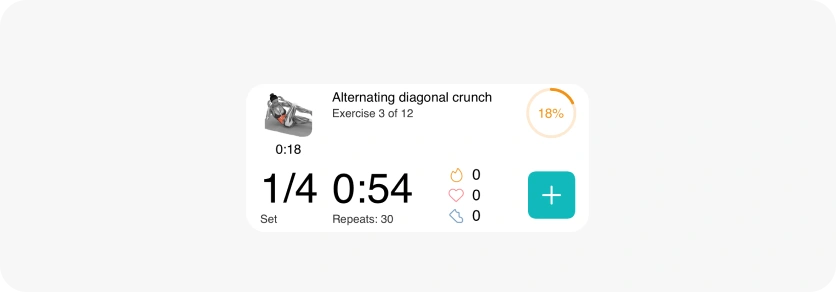
🏃♀️Get more ideas on how to engage health & wellness app users.
Travel apps: Flight & itinerary updates
Display gate changes, delays, boarding status, or baggage information in real time. Travelers get peace of mind without switching between apps or having to check notifications.
🛫 Combine push notifications with SMS to deliver crucial updates.
News & media apps: Election results & live polling
Show incoming tallies, shifts in projections, or real-time polling updates during major events.
🆕How do news & media apps boost engagement with push notifications? Find out in our exclusive data study.
Package delivery apps: Shipment progress
Help users track their package from dispatch to arrival, including “Out for Delivery” and “Delivered” events, without inbox noise.
Restaurant apps: Table wait times & order status
Let guests know when their table will be ready or when their pickup order is being prepared. This practice removes uncertainty and improves the customer experience.
Retail & e-commerce apps: BOPIS (buy online, pick up in store) updates
Provide real-time “Order ready,” “Order in pickup queue,” and “Order collected” statuses.
Best practices for high-performing iOS Live Activities
To make the most of Live Activities, your updates must be clear, relevant, and designed for quick, at-a-glance consumption. Use these Live Activities best practices to deliver a polished, engaging experience that feels native to iOS and valuable to your users.
Prioritize essential data
Live Activities should communicate the core status of an ongoing task — nothing more. Keep text minimal, highlight key numbers or progress, and remove anything that doesn’t help the user understand what’s happening right now.
Don’t expose sensitive data
Because Live Activities are visible on the Lock Screen, do not display:
- Personal messages
- Health metrics
- Financial data
- Personal identifiers
Instead, surface general summaries and route users to the app for anything sensitive.
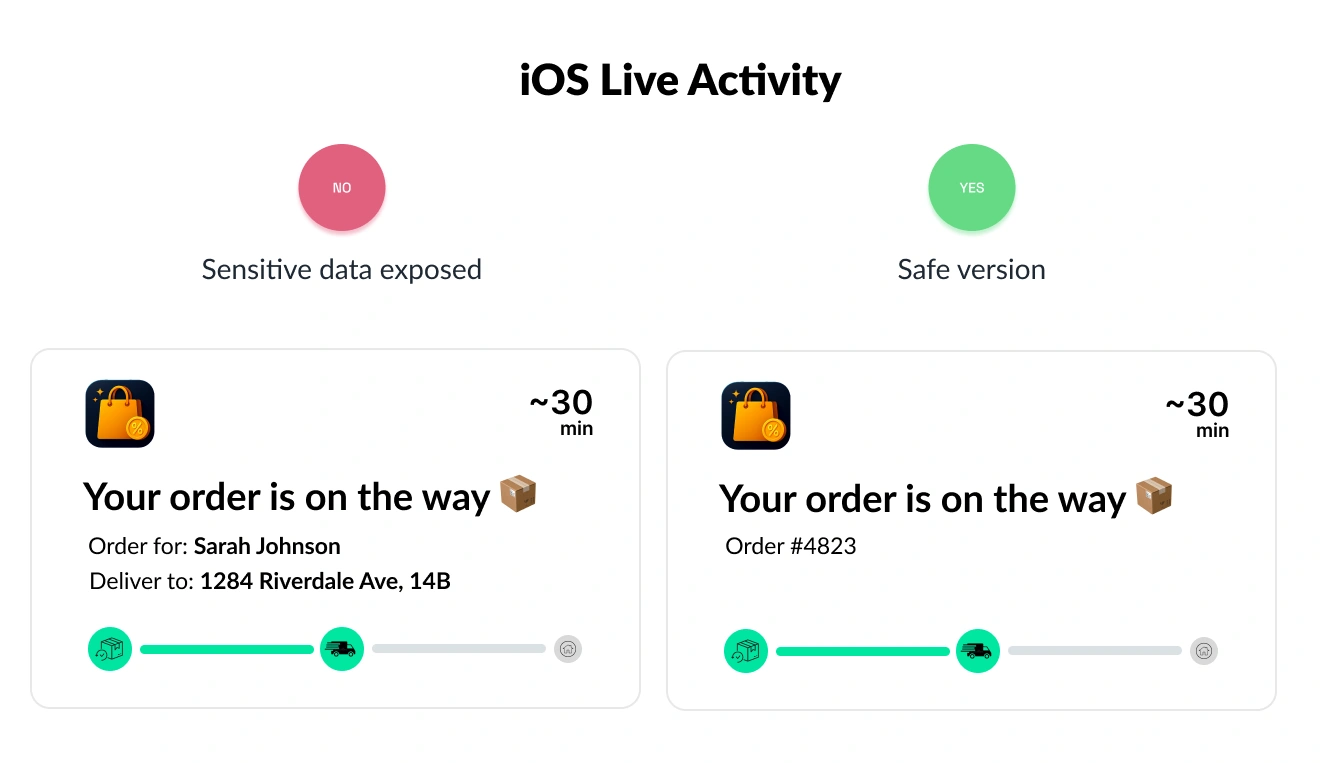
Design for all lock screen variations
A Live Activities push notification must remain clean, legible, and functional in every format: compact, expanded, StandBy mode, on Always-On Display, or in the Dynamic Island.
Test typography, spacing, and iconography across all surfaces to maintain consistency.
Optimize for the Dynamic Island
The Dynamic Island is where users glance most often. Keep the compact version simple and instantly readable, and use the expanded view for richer context. Short labels, recognizable icons, and clear status indicators work best.
Avoid promotional messaging
Apple strictly prohibits ads, offers, and marketing language in Live Activities. Stick to real-time, utility-focused updates tied to an active user task.
Promotional content should be handled through push notifications, in-app messages, or email instead.
Limit duration
Live Activities are designed for short-lived, real-time workflows, not long-running tracking. End them promptly once the event is complete to keep the experience fresh and to maintain user trust.
Use segmentation to avoid fatigue
Not every user needs every update. Use segmentation to show Live Activities only to users who may find them relevant. This ensures your real-time experiences feel helpful, not overwhelming.
How to create iOS Live Activities
Creating Live Activities doesn’t have to be a developer-heavy, time-consuming process. With Pushwoosh, you can enable, update, and manage Live Activities using the iOS SDK and Pushwoosh API. Here’s how it works:
startLiveActivityWithToken:: Start a Live Activity with a unique token.stopLiveActivity: Stop a Live Activity when it’s no longer needed.
This method allows your app to initiate and control Live Activities at the exact moment users take action, ensuring the Lock Screen reflects real-time progress instantly.
Managing Live Activities via API
If you use Pushwoosh via API, you get even more flexibility. You can manage and update a Live Activity’s content using the /updateLiveActivity method. This allows you to push updated information, such as an ETA change, new score, or delivery status, even when the app is closed or in the background.
This opens up a world of possibilities for creating highly customized, dynamic user experiences that stay perfectly in sync with real-time events.
Start using iOS Live Activities with Pushwoosh
iOS Live Activities are one of the most effective ways to keep users informed and engaged in real time, and with Pushwoosh, enabling them is easier than ever.
As a customer engagement platform, Pushwoosh gives your team everything needed to launch and manage iOS Live Activities with minimal effort: seamless API support, AI-powered content personalization and segment creation, and full compatibility with iOS 18.
Plus, Pushwoosh enables you to create omnichannel experiences across Live Activities, push notifications, in-app messages, email, SMS, and WhatsApp — all from one platform.

